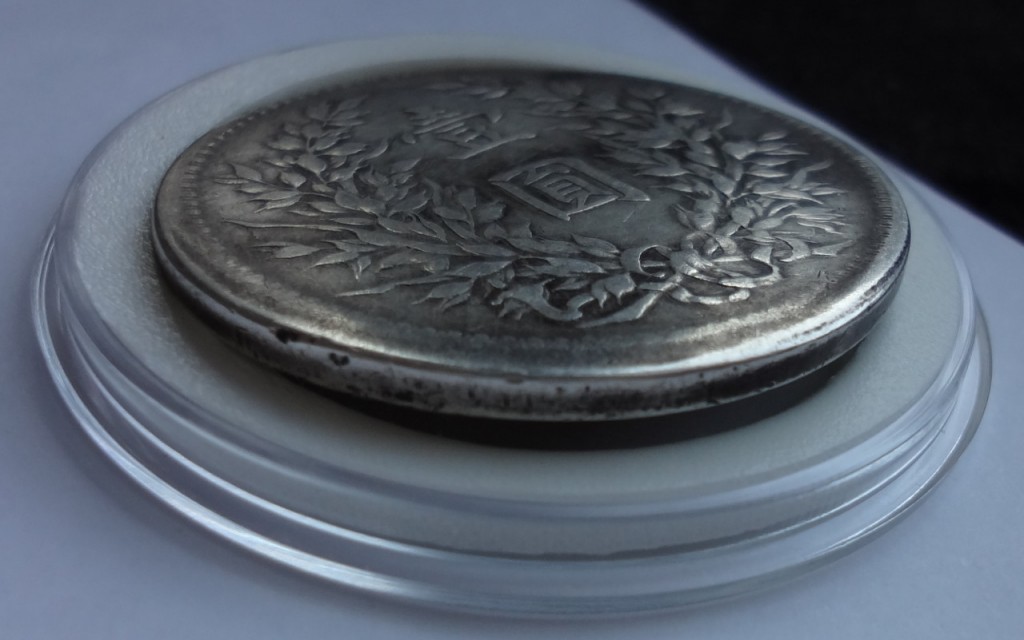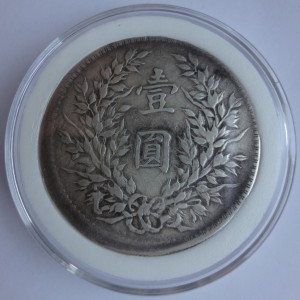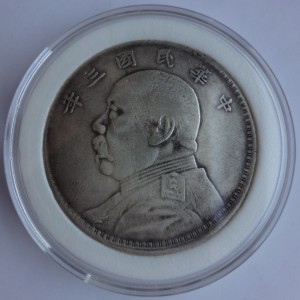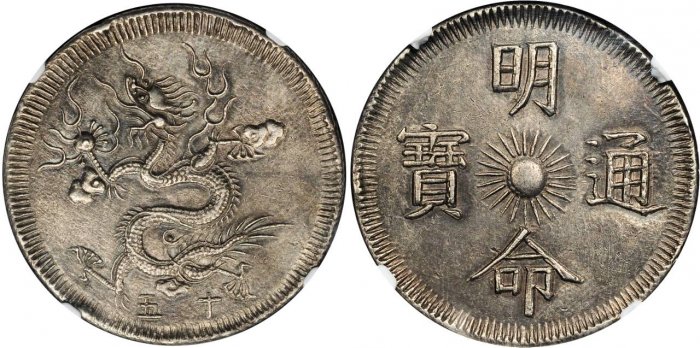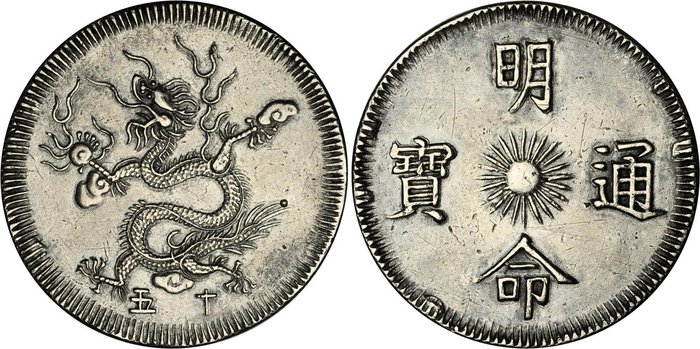The plain edge of this “Fatman dollar” is not the result of circulation wear. Despite being called 光边 in Chinese, literally “bald edge”, it has not been shaved either. The usual reeding was simply never fully impressed onto the coin blank. If you look carefully indeed, you will notice a thin reeded part up to 6 o’clock. This Yuan Shih Kai dollar has actually suffered a random minting error called “broadstrike“.
Modern coins are machine struck. A blank is automatically placed above the lower die (or anvil die), fixed to the bed of the machine. The collar die is then brought up so as to encircle the blank, as the upper die (hammer die) is brought down with tremendous pressure. This cause the soft metal to flow like a viscous solid: prevented from escaping on the sides by the collar, it effectively gets imprinted by filling the engraving of the dies. If the collar was crenated, the edge of the coin will thus be reeded. This mechanical process was repeated about one hundred times per minute by the coining presses available at the time, and failures would inevitably happen sometimes. Broadstrike is caused by a particular problem: the collar die which is supposed to raise and surround the blank may get stuck due to some accumulation of debris or grease. If that happens, the metal unconstrained by the collar expands and increases in diameter during the strike. This results in a coin with all its design elements present, but an expanded shape: a broadstrike.
In the case of this “Fatman dollar“, we can deduce from the very thin reeding that the collar was partially engaged. The side with no reeding, completely unrestrained by the collar die, expanded the most. This type of coins is referred to as uncentered broadstrikes. This kind of error provides informations about the minting process. The traces left by the collar being on the reverse part of the edge means that the Yuan Shi Kai portrait was engraved on the hammer die.
Such misshapen coins are the result of random errors, but are accounted for by the mint. They are systematically destroyed when found during counting and packing the coins for dispatch. Very few of these coins indeed manage to slip through the combined vigilance of counting machines and human assayers to end up circulating. Even then, due to their suspicious appearance, they often are the first to get melted down for their precious metal content. It is therefore very rare for these unloved coins to reach the hand of a caring collector!
This large silver coin could be a riddle even for Chinese readers. The reverse is similar to traditional Chinese coins – the name of the ruling Emperor, here “明命” (Míng Mìng in mandarin) and the characters 通寶 (coin of the realm). The obverse depicting the classical imperial flying dragon motif is also reminiscent of Chinese coinage, but its style and execution is unusual. Finally there is a date: 十五, 15th year of this Emperor era… It all looks all so very familiar, but there never was a “Ming Ming” emperor in China. Indeed, this coin is actually an early Vietnamese coin, issued in 1834, the 15th year of the rule of Emperor Minh Mạng!
Modern Vietnamese language is written using the latin alphabet, sprinkled with a lot of interesting diacritics, but this was not always the case. During their long history, Vietnam and China weaved a complex relationship together. For one millenium Vietnam was actually a Chinese vassal state, and this left a profound imprint on Vietnamese culture. China brought the Confucian society structure and Chinese characters to Vietnam, where they continued to evolve independently way after Chinese influence in the region had waned. This shared cultural background is the reason why this coin looks so familiar to the Chinese coin collector, in an uncanny way.
This “Minh Mạng thông bảo” coin has a face value of 7 tiền and 2 phân. The “tiền” unit is roughly similar to the Chinese 钱 (qián) unit we are accustomed to, and this silver coin weighs unsurprisingly about 27 grams. Its diameter is also comparable to Chinese dragon dollars at 40mm, but it actually predates them from half a century! The first Western-style dollar coins of the Asian continent were indeed actually made in Vietnam in 1832. Emperor Minh Mạng, despite the disdain he showed for European culture, had some interest for their technology and weaponry, which he sometimes imported in the otherwise very conservative Vietnamese society. These dollar coins are probably the result of one such experiment.
Vietnamese dollars were not machine struck – the Palace lacking a modern mint – but the blanks were cast like traditional cash coins then the design hammered. The fine details and sharpness of their surfaces despite being made with such a crude process is a testament to the care and mastery with which they were produced. Due to this process a lot of varieties exist, but these coins are rare, moreover in good condition and with sharp details. The coin pictured above is the most common variety for the year 1834, the stylized flames around the fireball in the dragon’s claws having two “forks”. A scarcer variety for the same year only has one of such “forks”.
These dragon dollars were nicknamed Phi Long, the Vietnamese reading for the Chinese characters 飞龙 (Fēi lóng). While they are very scarce and beautiful, these coins are still cheaper than Chinese coins of similar rarity: a 1834 7 tiền coin in AU grade is worth about $2500 USD at the time of this writing. The price of Vietnamese coins has risen sharply in recent years though, following the growth of the Chinese numismatic market. The shared cultural themes between the two countries makes old Vietnam coins attractive to Vietnamese and Chinese collectors alike. For example, the design of the rare 5 tiền coin shown below, made during the rule of Emperor Tự Đức, is actually a great visual pun with an auspicious meaning! Continue reading »
